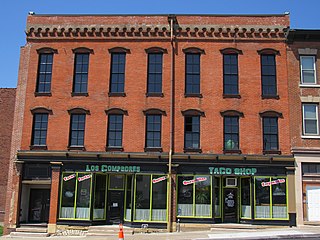
The Wupperman Block/I.O.O.F. Hall is a historic building located just north of downtown Davenport, Iowa, United States. It was individually listed on the National Register of Historic Places in 1983. In 2020 it was included as a contributing property in the Davenport Downtown Commercial Historic District.

The Henry Berg Building is a historic building located in downtown Davenport, Iowa, United States. It has been individually listed on the National Register of Historic Places since 1983. In 2020 it was included as a contributing property in the Davenport Downtown Commercial Historic District.

The Riepe Drug Store/G. Ott Block was located in downtown Davenport, Iowa, United States. It was listed on the National Register of Historic Places in 1983.
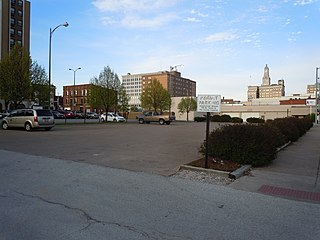
The Hoffman Building was a historic building located in downtown Davenport, Iowa, United States. The building was built around 1855. John V. Hoffman operated a grocery store in the shop on the first floor. He lived in the apartment on the second floor. The building was typical of Davenport's early commercial architecture with a steep-pitched side-gable roof. It featured a well-preserved cast-iron shop front. In its early days a long shed roof extended from the building and was supported by posts along the curb to shelter the sidewalk. It and was listed on the National Register of Historic Places in 1983. Like the Prien Building next door, Mueller Lumber Company across the street and the Riepe Drug Store/G. Ott Block on the 400 block of Second Street, it was torn down in the late 20th century.
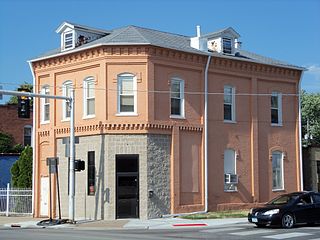
Koch Drug Store is a historic building located in the central part of Davenport, Iowa, United States. It is a Victorian style commercial building that was built in 1881. The structure was listed on the National Register of Historic Places in 1984.
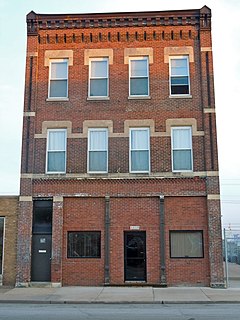
Meiser Drug Store is a historic building located in the West End of Davenport, Iowa, United States. It was built in 1888 and listed on the National Register of Historic Places in 1983. Amielius Meiser built this structure to house his drug store. He had previously operated an apothecary across the street, and he lived on the upper floors of both buildings. This building is noteworthy for the brick and metal cornice and the light colored stone used in the details.

Finley Guy Building is a historic building in central Davenport, Iowa, United States. The Spanish Colonial Revival structure was listed on the National Register of Historic Places in 1984.

Woeber Carriage Works, also known as the G. Hager & Co. Carriage Works and the Davenport Plow Works, is a historic building located on Lot 3, Block 20 of the original town of Davenport, Iowa, United States. It was listed on the Davenport Register of Historic Properties on November 15, 2000. In 2020 it was included as a contributing property in the Davenport Downtown Commercial Historic District on the National Register of Historic Places.

The Younker Brothers Department Store is a historic building located in downtown Des Moines, Iowa, United States. It was listed on the National Register of Historic Places in 2010.

The Baker-Devotie-Hollingsworth Block is an historic building located in the East Village of Des Moines, Iowa, United States. The eastern two-thirds of the block was listed on the National Register of Historic Places in 1978 as the Studio Building. The western one-third was added to the National Register in 2008, and its name was changed at that time. In 2019 the entire building was included as a contributing property in the East Des Moines Commercial Historic District.
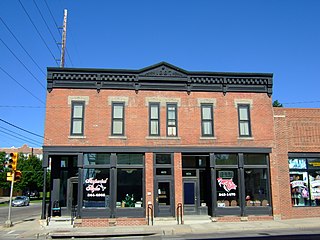
The Wherry Block, also known as Wherry's Hall, Scruby Brothers Grocery, and Scruby's Grocery Store, is a historic building located in Des Moines, Iowa, United States.
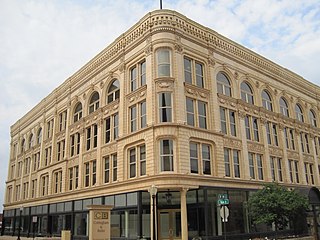
The Security Building, also known as the Stampfer Building, is a historic structure in Dubuque, Iowa, United States. The cream-colored building is associated with the J. F. Stampfer Co. department store.

G. Kerndt and Brothers Elevator and Warehouses, No. 11, No.12 and No. 13 is a historic complex located in Lansing, Iowa, United States. The four Kerndt brothers were all German immigrants who settled in the Lansing area by 1854. Gustav, William and Mortiz established a broom factory and cigar business in town while Herman farmed and provided the broom corn for the factory. A fifth brother, Julian, died shortly after arriving in Iowa. They built their first grain warehouse in the late 1850s. In 1861 they began their general store, which would in time include private banking as a part of their mercantile business. In 1908 it was incorporated by the family as the Kerndt Brothers Savings Bank.

Parker's Opera House, also known as Opera House Store, Woolworth's and Parker Place, is a historic building located in Mason City, Iowa, United States. It was designed by the prominent Des Moines architect William Foster. Cousins H.G. and A.T. Parker built this structure as an opera house, which was the first one in the community. While it initially filled a need in Mason City, it was replaced by more modern theatres around the turn of the 20th century. The third floor was created in the building in 1909 when it was placed across the middle of the auditorium. The first floor initially housed a clothing store, and F. W. Woolworth Company occupied it beginning in the mid-1920s, and the upper floors housed the local offices of the Standard Oil Company at the same time. The two-story addition in the rear was built in the 1960s. The first floor was redesigned in 1997 for Central Park Dentistry. The upper floors were converted into apartments in 2013.

The Ziepprecht Block is a historic building located in Dubuque, Iowa, United States. Completed in 1888, it is a fine example of transitional commercial Italianate architecture. The three-story brick structure features a heavy projecting cornice and rounded pediment from the Italianate, with larger paired windows from the Second Empire style, and three-sided bay windows from the Queen Anne style. It is also one of a small number of double storefront blocks that remain in the downtown area. The building is named for Henry Ziepprecht a German-born druggist who settled in Dubuque in 1856 and died in 1887. His estate paid to have this building constructed on the location of an older building that housed his drug store. Now managed by Joseph Wittmer, the drug store and a confectionery were the first businesses to occupy the storefronts. The upper floors housed apartments. The building was listed on the National Register of Historic Places in 2002.

German Bank is a historic building located in the Lower Main Street district of Dubuque, Iowa, United States. The city's German community was its most prominent ethnic group in the mid to late 19th century. Like many other cities in Iowa of that area it had banks that were owned by, and catered to, members of their particular immigrant communities. T.H. Thedinga, the city's first German-born mayor, started this bank in 1864 to serve immigrant Germans. In 1868 it moved from its original location on Main Street and into the former Dubuque Miners' Bank building. That building was torn down in 1901 in order to construct this one. It was designed by Dubuque architect John Spencer in partnership with Chicago architect W.G. Williamson. The three-story brick building has a highly decorative main facade composed of polished pink granite on the main floor and terra cotta on the upper two floors. Decorative elements include egg-and-dart, Greek fret, a row of small lions' heads, bay windows, scroll pediments, imperial German eagles, and a bracketed cornice with dentils. The second and third floors are dominated by four fluted, banded columns with Corinthian capitals.

The Hawthorne Glove and Novelty Company–Shrader Drug Company Building is a historic building located in Iowa City, Iowa, United States. Completed in 1906, this utilitarian three-story brick structure is located in the city's original railroad and industrial corridor south of the central business district. This was an industrial area from the 1870s to the 1940s. It replaced a recently built building on the same site by the Hawthorne Glove and Novelty Company that had been destroyed in a fire. The back of the building opened upon the rail sidings of a branch line of the Burlington, Cedar Rapids and Northern Railway, later the Chicago, Rock Island and Pacific. By the start of World War I the Shrader Drug Company occupied the building. It was one of three drug related factories that were located along the South Gilbert Street corridor at that time. The company name changed to the Hewell-Shrader Drug Company in 1930 and then the Hewell-Shrader Company in 1945 after farm fertilizer was added to its product line. The company closed in 1956, and the building was sold to the Thompson Transfer and Storage Company who used it for a warehouse. Whipple House Furniture Store took over the building three years later, and remained until 1975. In the intervening years a variety of businesses occupied the building until the 1980s when it was vacant for a period of time. In the mid-1980s The Vine Tavern occupied the basement level and the upper floors were used for artist studios. In 2012 the upper floors were converted into apartments. The building was listed on the National Register of Historic Places in 2014.

Smulekoffs Furniture Store, also known as the Sinclair Building, New Sinclair Building, Warfield–Pratt–Howell Co. building and the Churchill Drug Co. building, is a historic building located in Cedar Rapids, Iowa, United States. In 1901 Thomas Sinclair had the original section of this five-story brick structure built. It housed the wholesale grocer Warfield–Pratt–Howell Co. and another wholesaler, the Churchill Drug Co. It was the second of several large-scale warehouse buildings that were constructed in this section of the city along the Cedar River. A spur line of the Chicago, Milwaukee, St. Paul and Pacific Railroad was located at the rear of the building. Rosenbaum Furniture Store bought the building in 1925, and it was converted from warehouse use to retail. In 1941 Smulekoffs Furniture Store took over the building and renovated the main floor. They remained here until 2014. The building is slated for apartments on the upper floors and retail on the main floor. It was listed on the National Register of Historic Places in 2016.

The Flynn–Griffin Building, also known as the Flynn Block, Peoples' Savings Bank Building, and the Edna M. Griffin Building, is a historic building located in Des Moines, Iowa, United States. It was listed on the National Register of Historic Places in 2016.

The Eighth Street Historic District is located in Manitowoc, Wisconsin.






















